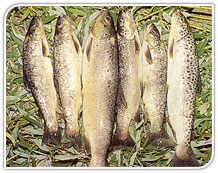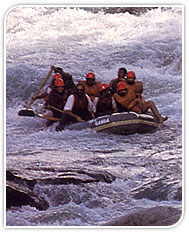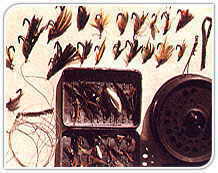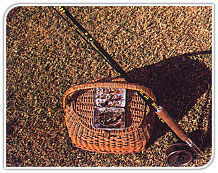Angling: Trout Fishing
 Unlike
the Mahseer, the Trout is not indigenous to Indian waters. The Snow Trout
is however fond in all high altitude streams and lakes. It was introduced
into various predetermined lakes and river in various parts of the
country. Trout hatcheries are in operatron in the Kashmir valley, Kulu
valley. Agoda near Uttrakashi and Avalanche in the Nilgiris. The Snow
Trout is however, touch in all high altitude streams and lakes.
Unlike
the Mahseer, the Trout is not indigenous to Indian waters. The Snow Trout
is however fond in all high altitude streams and lakes. It was introduced
into various predetermined lakes and river in various parts of the
country. Trout hatcheries are in operatron in the Kashmir valley, Kulu
valley. Agoda near Uttrakashi and Avalanche in the Nilgiris. The Snow
Trout is however, touch in all high altitude streams and lakes.
KASHMIR :
As early as 1895, some fingerlings were imported into India,
successfully bred at the hatchery near Kokemag, and later introduced into
carefully chosen streams and some high altitude lakes. Due to-prevailing
conditions the Brown Trout acclimatized under natural conditions. The
Rainbow Trout, cross-bred with the Brown, did not breed successfully in
the streams. Today the hardy Brown Trout is considered a local fish.
Rainbow Trout is however found on some selected beats, particularly the
upper ones. Stocking of the streams is came out periodically, when floods
wash out the rivers.
The Trout waters are divided into three
distinct types. Snowfed streams which include the Sindh, Lidder and
Bringhi rivers. These rivers have low but chilly water in the morning,
slightly muddy-water as the level rises due to the melting snow in the
afternoon, and are prone to flooding during the rains. The springfed
streams like Kokemag and Verinag are slower flowing and remain
comparatively unaffected by the monsoons. The Trout size is larger and the
heats are easier to fish. High altitude lakes like the Kishensar,
Vishensar and Gangabal lakes. One needs to trek up to these lakes located
at altitudes of 3500 metres. All camping gear and provisions must be
carried on these trips.
 MAJOR
TROUT WATERS IN KASHMIR
MAJOR
TROUT WATERS IN KASHMIR
River Sindh :
The river flows
along the main Srinagar-Leil highway towards the north west of Srinagar.
The furthest Trout beats are located about 65 kms away from Srinagar and
the nearest one is about 15 kms. The river flows through a narrow valley,
which widens out towards the lower beats. The river is wide and shallow at
places and long casting is necessary. The upper beats however are deep and
narrow, and turn muddy in the afternoons. Early or late Fishing is
recommended.
River Lidder :
The river originates
north of Pahalgam, north east of Srinagar, and has two major tributaries,
the Aru and Sheshnag which have their confluence at Pahalgam. Excellent
angling can be had all along the main river and its tributaries, all the
way down towards Brijbehara and Anantnag. Some Rainbow Trout can be landed
on the upper beats. The lower beats also have a local tish called the
'Chush' which is a species of Barrel. Interestingly, this Fish gets the
fly snagged in its side or one of Rafting on the Beas River the fins and
rarely in the mouth. It does not make good eating. Sizes of upto 10 Ibs
are not uncommon. Pahalgam, 90 kms from Srinagar and a convenient base for
these beats, has excellent hotels and lodges.
River Bringhi :
The river lies towards the eastern end S the valley. It runs along
the Anantnag -Dakshum Road beyond Acchabal. It has three tributaries: the
Dyus, Naubaug and the Alhan. The Bringhi river is generally narrow and the
bed is boulder-strewn. It has always been a great favourite with anglers.
A fair amount of Rainbow Trout can be found in the upper beats. Some very
large Trout can be landed on this stream. The lower beats also have some
Chush (Bartel). The Naubaug stream is shallow and uninteresting. Anglers'
lodges are located at Dakshum (approx. 100 kms from Srinagar) and Naubaug.
The river can also be conveniently approached from Kokemag where there is
a tourist lodge.
Kokemag Verinag :
The Kokemag and
Verinag streams are the two foremost springfed waters in the Kashmir
valley. They originate from natural perennial springs and hence remain
clear and fit for angling throughout the season and for the whole day.
Since the stream beds are not strewn with boulders, they are easy to fish
as one can walk comfortably along the banks. Pools created by placing
boulders across the stream hold some good-sized Brown Trout. Kokemag is
located about 60 kms from Srinagar, beyond Kazikund, en route to Banihal.
The stream originates from the spring source on the river Jhelum. The
angling conditions are the same as at Kokemag. There is a tourist lodge at
Verinag, set in beautiful gardens. One can see large Trout swimming in the
pond created at the source of the spring.
High Altitude
Lakes :
There are a number of high altitude lakes located in the
mountains north of the valley, which are well stocked with large-sized
Trout. The average altitude of these lakes is around 3000 metres and they
are only approachable by one to three-day treks. The Tarsar and Marsar
lakes are approached from Pahalgam while the Kishensar, Vishensar, Gadsar
and Gangabal lakes are approachable from Sonmarg, Gund or Nichnai. The
lakes are formed by the melting of snow and hence are crystal clear.
During the early season some ice floes can also be seen floating on the
lakes. Angling on the lakes is necessarily restricted to the banks. An
inflatable raft would be excellent to enable one to get to lesser-fished
areas. Long casts are necessary. There is no accommodation in these areas
and hence full camping equipment and provisions must be carried. Due to
fluctuating weather, water-proof and warm clothing must be carried.
EQUIPMENT
FOR TROUT FISHING IN KASHMIR :
 The
Brown or Rainbow Trout of the Kashmir waters is a good fighter like the
Salmon. It makes flashing runs interspersed with repeated leaps from the
water. A 2 or 3-pounder on a light fly rod is an unforgettable adventure.
Fly box, reel, cast and assortment of flies As per the trend in angling in
Kashmir, a set of two or three flies in tandem are tied on a cast of about
I metre length of 8 Ib. filament line. Some lead wire is used to ensure
sufficient casting weight. The average weight of Trout expected to be
landed is around l.5 Ibs. One should not, however, rule out the giant
5-pounder. The little fingerlings must be gently returned .to the river
without hurting them. As mentioned earlier, the bag is limited to six fish
only.
The
Brown or Rainbow Trout of the Kashmir waters is a good fighter like the
Salmon. It makes flashing runs interspersed with repeated leaps from the
water. A 2 or 3-pounder on a light fly rod is an unforgettable adventure.
Fly box, reel, cast and assortment of flies As per the trend in angling in
Kashmir, a set of two or three flies in tandem are tied on a cast of about
I metre length of 8 Ib. filament line. Some lead wire is used to ensure
sufficient casting weight. The average weight of Trout expected to be
landed is around l.5 Ibs. One should not, however, rule out the giant
5-pounder. The little fingerlings must be gently returned .to the river
without hurting them. As mentioned earlier, the bag is limited to six fish
only.
Suggested equipment is as follows:
ROD: A light fly rod 8
to 10 ft. long.
REEL: A medium-sized spool type fly reel should
comfortably hold about 25 metres of coated silk line.
FLIES:
Recommended flies include March Brown, Teal and Green, Coachman, Peacock,
Butcher, Watson's Fancy, Coch-y-Bondhu, Zulu etc. Some colour variations
from those mentioned could yield good results. Wet (Spider) hackle flies,
winged wet, dry fly spiders and winged dry flies are all use nil. Hook
sizes for fly dressing vary between No. 12 and 16. Two hooked tabys or
lures are also productive when used as the. lead fly at the end of the
cast.. Other items like a folding landing net with a four foot handle, fly
box, spare nylon line for casts, lead wire for weight, a long nose plier,
a hook disgorger, and some thick Tine to carry the bag. Some excellent
willow wicker baskets are available in Srinagar to hold all the gear in
case a satchel is not available.
 Note
: Excellent angling gear is available for hire at nominal cost at a number
of tackle shops in Srinagar. Well-cratted local flies are available for
sale as well. The Trout fishing season in Kashmir falls between March and
October,
Note
: Excellent angling gear is available for hire at nominal cost at a number
of tackle shops in Srinagar. Well-cratted local flies are available for
sale as well. The Trout fishing season in Kashmir falls between March and
October,
PERSONAL CLOTHING:
The following items of
clothing are recommended for angling in Kashmir: A trimmed felt hat.
Light-tinted sun glasses. A pair of warm gloves. A warm water-proof
jacket. Heavy cotton trousers. Extra woolen socks. A spare pair of kids. A
pair of waders (wet suit only when very cold). Insect repellant. Note :
Carry enough warm clothing and spares as the weather can turn chilly.
Click
Here for Trout Fishing in Nilgiri & Other Locations
 Unlike
the Mahseer, the Trout is not indigenous to Indian waters. The Snow Trout
is however fond in all high altitude streams and lakes. It was introduced
into various predetermined lakes and river in various parts of the
country. Trout hatcheries are in operatron in the Kashmir valley, Kulu
valley. Agoda near Uttrakashi and Avalanche in the Nilgiris. The Snow
Trout is however, touch in all high altitude streams and lakes.
Unlike
the Mahseer, the Trout is not indigenous to Indian waters. The Snow Trout
is however fond in all high altitude streams and lakes. It was introduced
into various predetermined lakes and river in various parts of the
country. Trout hatcheries are in operatron in the Kashmir valley, Kulu
valley. Agoda near Uttrakashi and Avalanche in the Nilgiris. The Snow
Trout is however, touch in all high altitude streams and lakes.  MAJOR
TROUT WATERS IN KASHMIR
MAJOR
TROUT WATERS IN KASHMIR  The
Brown or Rainbow Trout of the Kashmir waters is a good fighter like the
Salmon. It makes flashing runs interspersed with repeated leaps from the
water. A 2 or 3-pounder on a light fly rod is an unforgettable adventure.
Fly box, reel, cast and assortment of flies As per the trend in angling in
Kashmir, a set of two or three flies in tandem are tied on a cast of about
I metre length of 8 Ib. filament line. Some lead wire is used to ensure
sufficient casting weight. The average weight of Trout expected to be
landed is around l.5 Ibs. One should not, however, rule out the giant
5-pounder. The little fingerlings must be gently returned .to the river
without hurting them. As mentioned earlier, the bag is limited to six fish
only.
The
Brown or Rainbow Trout of the Kashmir waters is a good fighter like the
Salmon. It makes flashing runs interspersed with repeated leaps from the
water. A 2 or 3-pounder on a light fly rod is an unforgettable adventure.
Fly box, reel, cast and assortment of flies As per the trend in angling in
Kashmir, a set of two or three flies in tandem are tied on a cast of about
I metre length of 8 Ib. filament line. Some lead wire is used to ensure
sufficient casting weight. The average weight of Trout expected to be
landed is around l.5 Ibs. One should not, however, rule out the giant
5-pounder. The little fingerlings must be gently returned .to the river
without hurting them. As mentioned earlier, the bag is limited to six fish
only.  Note
: Excellent angling gear is available for hire at nominal cost at a number
of tackle shops in Srinagar. Well-cratted local flies are available for
sale as well. The Trout fishing season in Kashmir falls between March and
October,
Note
: Excellent angling gear is available for hire at nominal cost at a number
of tackle shops in Srinagar. Well-cratted local flies are available for
sale as well. The Trout fishing season in Kashmir falls between March and
October,